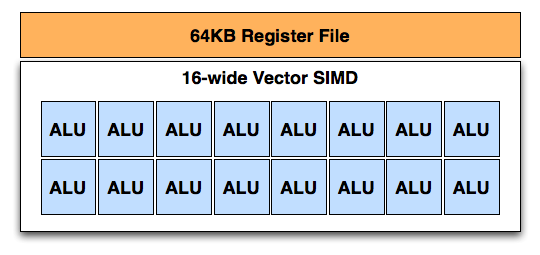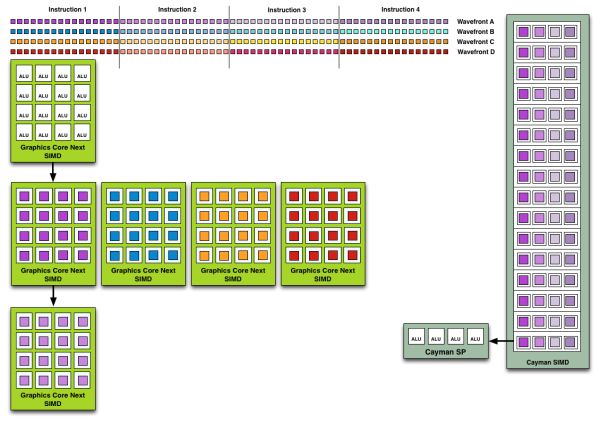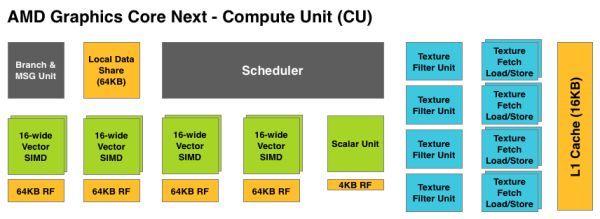AMD Radeon HD 7970 Review: 28nm And Graphics Core Next, Together As One
by Ryan Smith on December 22, 2011 12:00 AM EST- Posted in
- GPUs
- AMD
- Radeon
- ATI
- Radeon HD 7000
A Quick Refresher, Cont
Having established what’s bad about VLIW as a compute architecture, let’s discuss what makes a good compute architecture. The most fundamental aspect of compute is that developers want stable and predictable performance, something that VLIW didn’t lend itself to because it was dependency limited. Architectures that can’t work around dependencies will see their performance vary due to those dependencies. Consequently, if you want an architecture with stable performance that’s going to be good for compute workloads then you want an architecture that isn’t impacted by dependencies.
Ultimately dependencies and ILP go hand-in-hand. If you can extract ILP from a workload, then your architecture is by definition bursty. An architecture that can’t extract ILP may not be able to achieve the same level of peak performance, but it will not burst and hence it will be more consistent. This is the guiding principle behind NVIDIA’s Fermi architecture; GF100/GF110 have no ability to extract ILP, and developers love it for that reason.
So with those design goals in mind, let’s talk GCN.
VLIW is a traditional and well proven design for parallel processing. But it is not the only traditional and well proven design for parallel processing. For GCN AMD will be replacing VLIW with what’s fundamentally a Single Instruction Multiple Data (SIMD) vector architecture (note: technically VLIW is a subset of SIMD, but for the purposes of this refresher we’re considering them to be different).

A Single GCN SIMD
At the most fundamental level AMD is still using simple ALUs, just like Cayman before it. In GCN these ALUs are organized into a single SIMD unit, the smallest unit of work for GCN. A SIMD is composed of 16 of these ALUs, along with a 64KB register file for the SIMDs to keep data in.
Above the individual SIMD we have a Compute Unit, the smallest fully independent functional unit. A CU is composed of 4 SIMD units, a hardware scheduler, a branch unit, L1 cache, a local date share, 4 texture units (each with 4 texture fetch load/store units), and a special scalar unit. The scalar unit is responsible for all of the arithmetic operations the simple ALUs can’t do or won’t do efficiently, such as conditional statements (if/then) and transcendental operations.
Because the smallest unit of work is the SIMD and a CU has 4 SIMDs, a CU works on 4 different wavefronts at once. As wavefronts are still 64 operations wide, each cycle a SIMD will complete ¼ of the operations on their respective wavefront, and after 4 cycles the current instruction for the active wavefront is completed.
Cayman by comparison would attempt to execute multiple instructions from the same wavefront in parallel, rather than executing a single instruction from multiple wavefronts. This is where Cayman got bursty – if the instructions were in any way dependent, Cayman would have to let some of its ALUs go idle. GCN on the other hand does not face this issue, because each SIMD handles single instructions from different wavefronts they are in no way attempting to take advantage of ILP, and their performance will be very consistent.

Wavefront Execution Example: SIMD vs. VLIW. Not To Scale - Wavefront Size 16
There are other aspects of GCN that influence its performance – the scalar unit plays a huge part – but in comparison to Cayman, this is the single biggest difference. By not taking advantage of ILP, but instead taking advantage of Thread Level Parallism (TLP) in the form of executing more wavefronts at once, GCN will be able to deliver high compute performance and to do so consistently.
Bringing this all together, to make a complete GPU a number of these GCN CUs will be combined with the rest of the parts we’re accustomed to seeing on a GPU. A frontend is responsible for feeding the GPU, as it contains both the command processors (ACEs) responsible for feeding the CUs and the geometry engines responsible for geometry setup. Meanwhile coming after the CUs will be the ROPs that handle the actual render operations, the L2 cache, the memory controllers, and the various fixed function controllers such as the display controllers, PCIe bus controllers, Universal Video Decoder, and Video Codec Engine.
At the end of the day if AMD has done their homework GCN should significantly improve compute performance relative to VLIW4 while gaming performance should be just as good. Gaming shader operations will execute across the CUs in a much different manner than they did across VLIW, but they should do so at a similar speed. And for games that use compute shaders, they should directly benefit from the compute improvements. It’s by building out a GPU in this manner that AMD can make an architecture that’s significantly better at compute without sacrificing gaming performance, and this is why the resulting GCN architecture is balanced for both compute and graphics.












292 Comments
View All Comments
GenSozo - Thursday, December 22, 2011 - link
Style? Another possibility is that he has no life, a heavily worn F5 key, and lots of angst.Blaster1618 - Monday, December 26, 2011 - link
One request when diving into acronyms (from the “quick refresher”), first one is followed by (definition in parenthesis) or hyperlink. Your site does the best on the web at delving into and explaining the technical evolution of computing. You maybe even able to tech the trolls and shills a thing or to they can regurgitate at there post X-mas break circle jerk. Never underestimate the importance or reach of your work.lordken - Friday, January 6, 2017 - link
mmh quite far from disappointing, still running on 7950 as of today [5 years later] :)Concillian - Thursday, December 22, 2011 - link
Page 1Power Consumption Comparison: Columns: AMD / Price / NVIDIA
Presumably mislabeled.
Anand Lal Shimpi - Thursday, December 22, 2011 - link
Fixed, thank you!Take care,
Anand
Penti - Thursday, December 22, 2011 - link
Will the new video decode engine either add software accelerated gpu or fixed function hardware WebM/VP8 video decode? ARM SoC's basically already has those capabilities with rock-chip including hw-decoding, TI OMAP IVA3 DSP-video processor supporting VP8/WebM, Broadcom supporting it in their video processor and others to come. Would be odd to be able to do smooth troublefree 1080p WebM on a phone or tablet, but not a desktop and laptop computer without taxing the cpu and buses like crazy. It's already there hardware-wise in popular devices to do if they add software/driver support for it.Nice to see a new generation card any how.
Ryan Smith - Thursday, December 22, 2011 - link
It's UVD3, the same decoder that was on Cayman. So if Cayman can't do it, Tahiti can't either.MadMan007 - Thursday, December 22, 2011 - link
Pretty sure the chart on the first page should be labeled Price Comparison not Power Consumption Comparison.Unless perhaps this was a sly way of saying money is power :)
descendency - Thursday, December 22, 2011 - link
You list the HD 6870 as 240 on the first page ("AMD GPU Specification Comparison" chart) but then list it as around 160 in the "Winter 2011 GPU Pricing Comparison" chart. 80 dollars is quite a difference.Anand Lal Shimpi - Thursday, December 22, 2011 - link
Fixed, sorry those were older numbers.Take care,
Anand